The steps & principles of purchasing a ball mill
As we all know, ball mill equipment is a professional equipment for grinding materials. From the beginning of grinding metallurgy and mining industry, it has flourished in many industries. Now the more common ones are quartz sand ball mill, cement ball mill, ceramic ball mill, rubber lining ball mill, white ash ball mill, Calcium powder ball mill, etc., so the selection of ball mill equipment is more complicated.
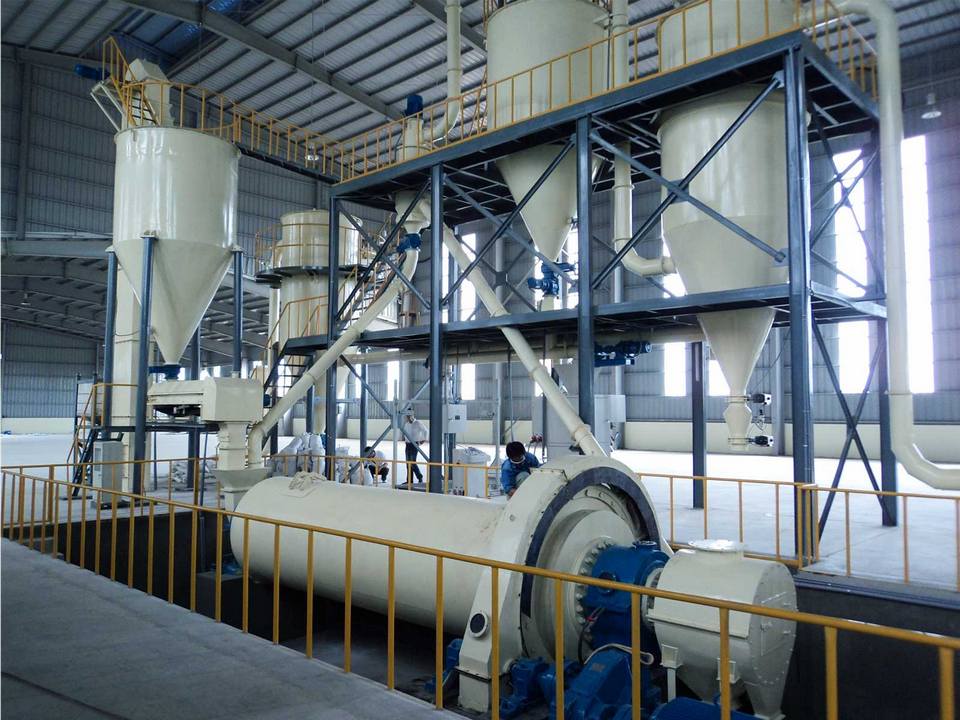
Select the corresponding type of ball mill equipment according to our own materials. For example, the materials to be ground are slag, quartz sand, steel slag, etc., then we choose the corresponding type of ball mill: slag ball mill, quartz sand ball mill, steel slag ball mill, the following takes quartz sand ball mill as an example .
The material to be ground is quartz sand. It is necessary to estimate the daily output of the quartz sand ball mill production line, and then select the corresponding type of quartz sand ball mill according to the output. The principle of choosing the model of quartz sand ball mill is that it is not too big, not too small, just right, because the small model will lead to the failure of the original planned production, and the large model will waste resources and occupy a larger area of land and so on.
It is very important to determine the type and model of the ball mill, but it is more important to find the right ball mill manufacturer, because the ball mill equipment manufacturer is related to the quality, process and after-sales service of the ball mill, and the quality of the ball mill is related to the stability of the later production. The advanced ball mill grinding process can improve the quality of the grinding materials, and at the same time, it can also increase the output and reduce the energy consumption. Ball mill equipment belongs to a kind of mechanical equipment, and all kinds of mechanical equipment cannot be guaranteed to be foolproof. In the long-term use process, problems with ball mill equipment are inevitable. Contact the manufacturer as soon as possible, and timely repair of the problem is the important part of after-sales service. Therefore, high-quality after-sales service can not only quickly repair the ball mill equipment, but also improve the production efficiency of the ball mill production line. .
Precautions for the use of supersonic jet mill
A supersonic jet mill is a machine that grinds large-sized solid materials to the required size. According to the size of the ground material or crushed material, the mill can be divided into a coarse crusher, a medium crusher, a fine mill, and an ultra-fine mill. There are four kinds of external forces applied to the solid during the grinding process: rolling, shearing, impact and grinding. Compression rolling is mainly used for coarse and medium crushing, suitable for the crushing of hard materials and bulk materials; shearing is mainly used for fine crushing, suitable for grinding tough materials; impact is mainly used for medium crushing, fine grinding and ultra-fine grinding, suitable for It is suitable for the crushing of brittle materials; the grinding is mainly used for fine grinding and ultra-fine grinding, suitable for the grinding of small pieces and fine particles.
The working principle of supersonic jet mill:
The compressed gas is passed through the feeding injector, and the grinding material is brought into the grinding chamber, and is sprayed tangentially to the grinding wall under the driving of the high-speed airflow from multiple nozzles to achieve the effect of friction grinding. The grinding fineness is controlled by adjusting the longitudinal depth of the grinding chamber, adjusting the grinding pressure or the feeding speed. Compared with the fluidized bed jet mill, the controllability of the grinding fineness is less, but it has a good grinding effect for materials with viscosity.
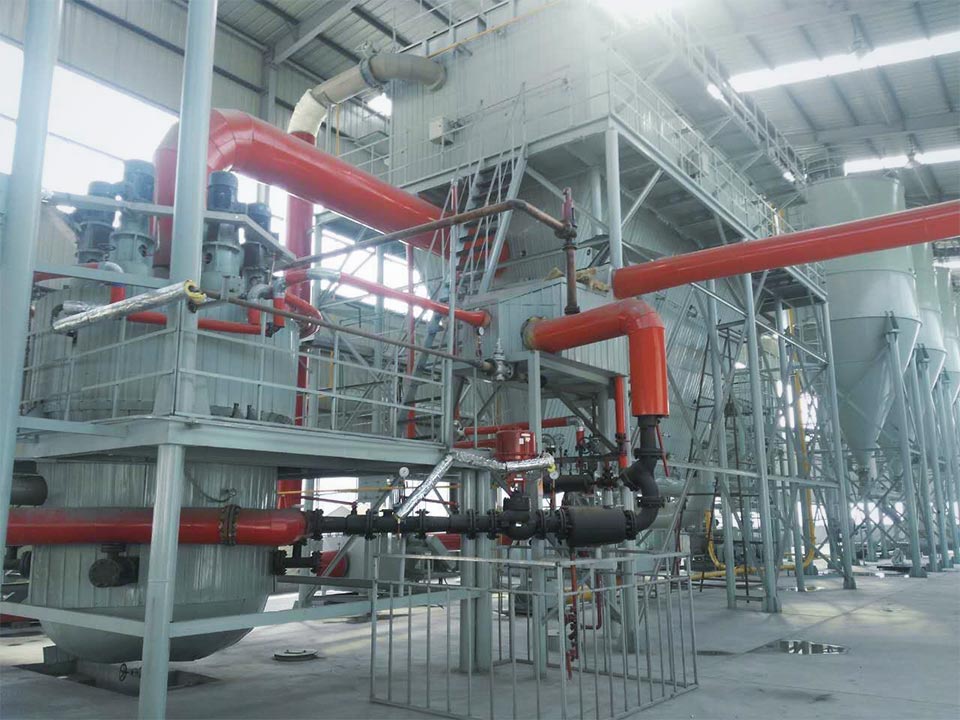
Features of supersonic jet mill:
1. It is suitable for ultra-fine grinding of dry powder materials, with large impact particle size, which can reach Mach 2.5 or more, and general materials can be easily crushed to 1-10 microns.
2. The relative fluidized bed jet mill has a good grinding effect on viscous materials, and the grinding process will not cause the phenomenon of blocking materials and unable to grind.
3. No temperature rise, the temperature of the crushing process drops due to the compressed gas nozzle, and there is no mechanical friction process, so the crushing process will not heat up, and it is suitable for the crushing of heat-sensitive and low-melting materials.
4. The equipment is simple, easy to clean, easy to operate and maintain, small footprint, low noise and no vibration.
5. Less investment, according to customer needs, unnecessary equipment such as dust collectors, fans, control boxes, etc. can be eliminated.
Supersonic jet mill in use need to pay attention to these matters:
1. During the production process, the temperature rise of the bearing must be checked frequently. When the temperature rise exceeds 50 °C, it should be stopped for inspection to find out the cause and eliminate the fault.
2. When the new machine is running, the transmission belt is easy to stretch, and attention should be paid to adjusting the proper tightness of the belt to ensure the working life of the belt.
3. The wearing parts should be checked frequently and replaced in time to ensure the production quality and production volume.
4. The wear of the blade and the bushing should be checked frequently. If it is worn, the productivity will drop, and the particle size will become coarser. If it is worn, it will be replaced.
5. The main engine and graded flow bearings are grease lubricated.
6. The grease replacement period of the bearing is 2000 hours, and the filling amount of the grease is 1/2 (upper measurement) or 3/4 (lower measurement) of the space in the bearing cavity. Do not overfill the grease, otherwise it will cause the bearing. Temperature is too high.
7. The grease changing period of the screw feeder is 4000 hours, add ordinary calcium-based grease.
Advantages of ultra-fine jet mill
Ultra-fine jet mill is a kind of equipment for producing ultra-fine powder. It is the equipment with smaller fineness on the market at present. It is suitable for building materials, chemicals, fillers, plastics, papermaking, coatings and other industries.
After the large block material is crushed to the required particle size by the hammer crusher, it is sent to the silo of the ultra-fine jet mill by the elevator, and fed into the main machine evenly and continuously through the feeding equipment. Under the action of centrifugal force, the material is scattered around from the bulk material disc and falls into the grinding chamber, where it is impacted, rolled and ground by the grinding rollers. Ultra-fine grinder has the following characteristics.
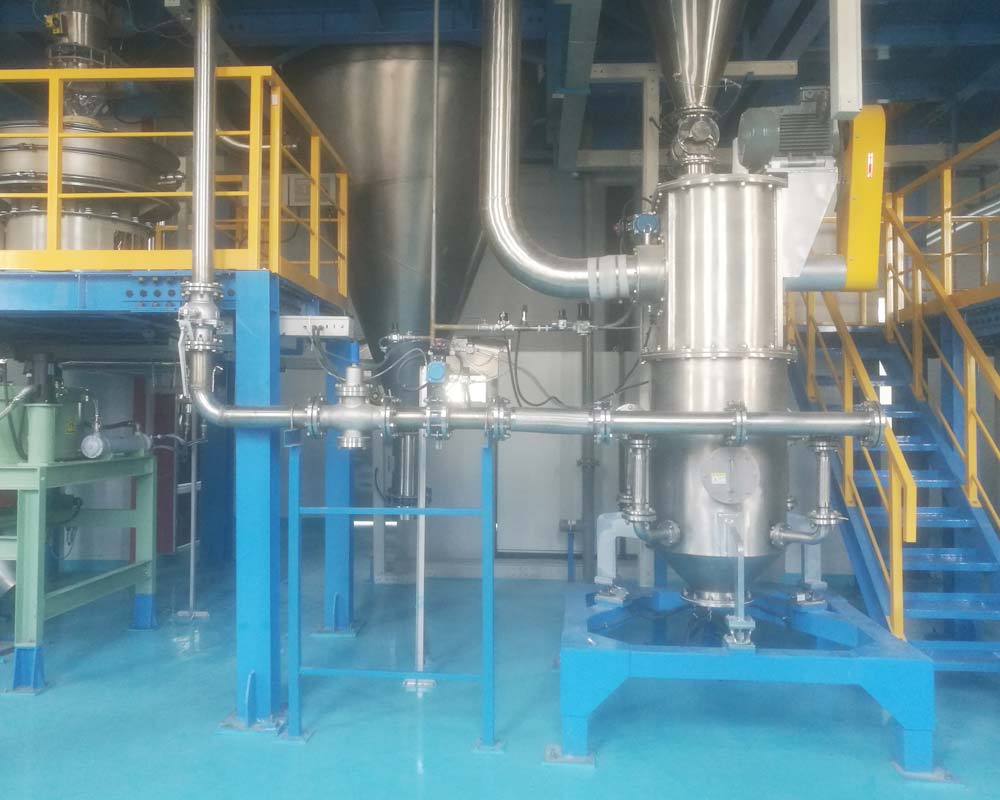
- High production efficiency
The new design of the grinding roller grinding ring improves the grinding efficiency. The results show that when the particle size and power of the finished product are the same, the efficiency of the stirring mill is increased by 40%, which is more than double the output of the ball mill, but the energy consumption of the system is only 30% of the airflow consumption.
- Low operating cost
Grinding rollers and grinding rings are forged with special materials, which improves the utilization rate. Compared with impact grinder and eddy current grinder, the finished product has the same fineness, and the service life of vulnerable parts is extended by 2-3 times. When processing calcium carbonate and calcite, the service life can reach 2-5 years.
- The product is in good condition
The cage type powder separator effectively improves the powder selection accuracy, and can configure the multi-cage powder separator according to the user's requirements such as output, fineness, and sieving rate. The product fineness can be adjusted arbitrarily between 325 meshes and 2500 meshes, and the single product fineness can reach d97≤5 microns.
- Continuous production process
Since there is no movable bearing and no screw in the grinding chamber, there is no problem that the bearing and its seal are easily damaged, and there is no problem that the screw is easy to loosen and damage the machine. It is externally lubricated with the main shaft, which can realize non-stop lubrication in the external machine, and non-stop production for 24 hours.
- Wide range of application
It can be widely used for grinding more than 100 kinds of materials such as calcite, chalk, limestone, dolomite, kaolin, bentonite, talc, mica, graphite, fluorite, phosphate rock, potassium ore, pumice and so on. In addition, according to materials, output, fineness and other aspects, combined with industry experience, multi-scheme configuration can be carried out to meet the needs.
- Clean and environmentally friendly
Using high-efficiency pulse dust collector, the complete set of equipment has no dust pollution, and is equipped with silencing device and anechoic chamber to reduce environmental noise.
Characteristics and typical models of jet mill
With the rapid development of the global economy, the powder industry is booming, and powder equipment, especially ultra-fine grinding equipment, plays a key role in it. The jet mill is one of the most common ultra-fine grinding equipment.
Jet mill, also known as jet mill, jet mill or fluid energy mill. The dry and oil-free compressed air or superheated steam is accelerated into supersonic airflow through the Laval nozzle. The ground material reaches the classification area with the air flow, the material that meets the required fineness is finally collected by the collector, and the material that does not meet the requirement is returned to the grinding chamber to continue grinding until it reaches the required fineness and is collected.
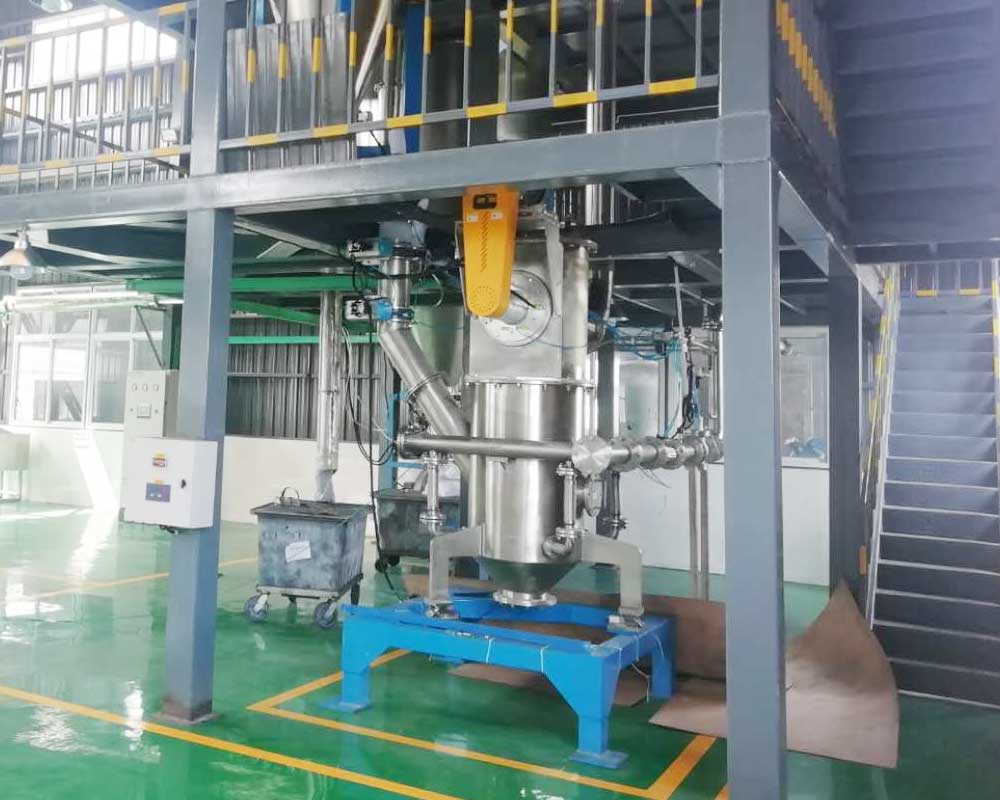
Features of jet mill
Jet mill is widely used for ultra-fine grinding of non-metallic minerals, chemical raw materials, health food, rare earth, etc. below medium hardness such as talc, marble, kaolin, etc.; it can also be used to grind low melting point and heat sensitive materials.
- Advantages
The products processed by the jet mill have the characteristics of high purity, high activity, good dispersibility, and smooth particle surface. In addition, the production method is dry production, which does not require dehydration and drying of materials, so it is very popular in the grinding industry.
- Disadvantages
The equipment manufacturing cost is high, the one-time investment is large, the energy consumption is high, and the powder processing cost is high; it is difficult to produce sub-micron products; the single-machine processing capacity of the jet mill is small, and it cannot meet the needs of large-scale production. In addition, the processing accuracy of the equipment The wear problem with the material is still a big problem.
Classification of jet mills
According to the way the particles are ground, it can be divided into single air flow type and multi-air flow type; according to the type of fluid medium, it can be divided into high-speed air flow type and hot steam flow type; It is divided into flat jet mill, circulating jet mill, target jet mill, counteract jet mill, and fluidized bed jet mill. Among them, the fluidized bed jet mill has obvious advantages and represents the mainstream direction of the development of jet mill equipment.
- Fluidized bed jet mill
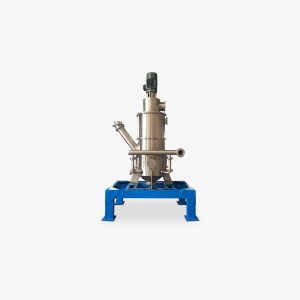
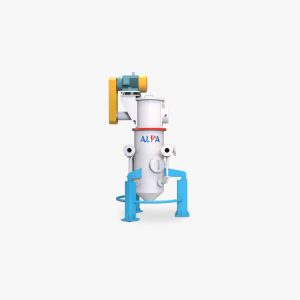
It is mainly composed of grinding nozzle, grading rotor, grading shaft air seal device, discharge pipe air seal device, discharge pipe, grading motor, feeding device and other parts. Fluidized bed jet mill has many advantages, such as high crushing efficiency, low energy consumption, light wear and less pollution, small equipment size, small footprint, high degree of automation, low noise, large production capacity, and suitable for large-scale production. The current ultrafine grinding equipment is widely used.
- Horizontal disc jet mill
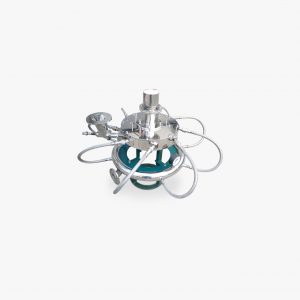
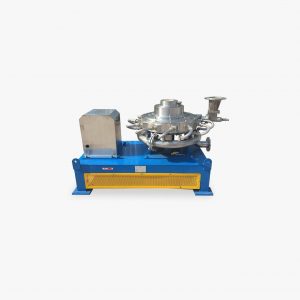
Horizontal disc jet mill, also known as flat jet mill, is the earliest jet mill in industry. It is mainly composed of a feeding system, an air intake system, a grinding-classification and a discharging system. This jet mill is mainly impact grinding, grinding and shredding at the same time, and has the function of self-classification. The structure is simple, the operation is simple, and it has the function of automatic classification. If the hardness of the material to be ground is high, the material will be damaged due to the high-speed movement of the airflow and the inner wall of the grinding chamber, which will cause severe friction, which will also cause a certain degree of pollution to the product.
- Circulating tubular jet mill
The main grinding parts of the circulating tubular jet mill are the feeding ejector and the grinding chamber. The main machine is simple in structure and easy to operate; it has automatic grading function while grinding; the main machine is small in size and large in production capacity; the product fineness is good, up to 3~0.2μm. The impact and wear of the air flow and the material on the inner wall of the tube are too serious, so it is not suitable for the refinement of materials with higher hardness. The grinding efficiency is the lowest among all types of jet mills, and the energy consumption is the largest.
- Jet mill
Jet jet mill, also known as reverse jet mill, is a device in which materials collide with themselves in supersonic airflow to achieve ultra-fine grinding. The production capacity is large, which avoids the wear of the particles on the pipe wall and the pollution of the powder particles by the pipe wall material, and can produce ultra-fine powder with high material hardness. The structure is complex, the volume is huge, and the energy consumption is high, and the gas-solid mixed flow still has certain wear on the grinding chamber and pipes.
- Target jet mill
Target jet mill, also known as single jet jet mill, is a device that makes materials impact fixed or movable target plates of various shapes at high speed for grinding. Simple and easy to operate; large grinding force and high grinding efficiency, especially for the grinding of low melting point, heat-sensitive materials and high molecular polymers. The product is thick and the energy consumption is large; the high-speed moving material particles and air flow have a strong erosion effect on the target plate, and the target plate is seriously worn, which will cause product pollution.
All in all, there are many types of ultra-fine jet milling equipment, and there are obvious differences in the structure of each type of equipment, with corresponding advantages and disadvantages. In the future, the development trend of ultra-fine jet mill equipment will focus on: increasing the output of a single machine and reducing the energy consumption per unit product; improving the product fineness and strengthening the crushing limit of the equipment; online control of product fineness and particle size distribution.
Article source: China Powder Network
The cause of abnormal sound in the ultra-fine grinder
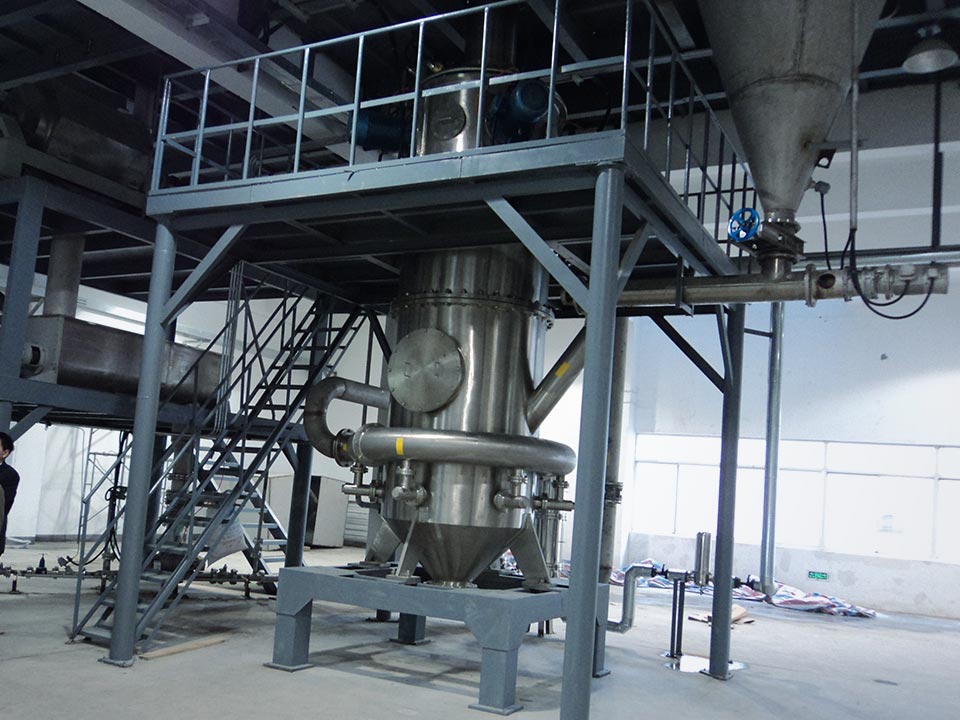
1. Severe overload causes a heavy "humming" sound inside the ultra-fine grinder contactor.
2. Due to poor contact or breakdown inside, the discharge point occurs, which is the "squeak" or "crack" sound inside the electromechanical disk of the traditional Chinese medicine ultra-fine grinder.
3. Due to the loosening of some parts such as connecting bolts on the top cover of the ultra-fine grinder, the iron core of the traditional Chinese medicine ultra-fine grinding machine is not tightened, causing the vibration of the silicon steel sheet and making a strong noise. If the silicon steel sheets on both sides of the iron core are not tightened, abnormal noise will also occur.
4. When there is a grounding or short-circuit fault in the power grid, a large current flows through the winding, and a strong noise will be emitted.
5. When there are large power equipment or equipment that can generate harmonic current in the ultra-fine grinder, the startup of the large-scale ultra-fine grinding machine equipment or the operation of the ultra-fine grinding machine that generates harmonics may affect the transformer on the site of the ultra-fine grinder. Make a "wow" sound.
6. Due to the ferromagnetic resonance, the transformer on the construction site will make an abnormal sound.
7. If the primary side voltage is too high or unbalanced in the ultra-fine grinder, there will be a little sound.
8. There is overvoltage, the winding or the lead wire is discharged to the shell, or the ground wire of the iron core is disconnected, causing the iron core to discharge to the shell, all of which are the discharge sound of the transformer on the construction site of the traditional Chinese medicine ultra-fine grinding machine.
When abnormal noise occurs in the transformer used in the ultra-fine grinder, the possible cause should be judged. Only when the ultra-fine grinder is well maintained can it work better.
Application characteristics & common troubleshooting of spiral jet mill
The grading wheel of the jet mill is divided into vertical and horizontal installations, but no matter which type, its composition includes the transmission motor, the grading wheel, the fine powder discharge port, the raw material inlet and the air inlet. It is widely used in many industries and is an excellent Machine tool.


The spiral jet mill can be applied to calcite, barite, quartz, gypsum, silica, corundum, cement, alumina, etc. Its application characteristics are introduced below.
1. Reduce cost, suitable for low value-added coarse powder.
2. Simple structure, convenient maintenance, few wearing parts, low operating noise and low energy consumption.
3. The classifier adopts large-diameter single-stage classifying wheels to improve production capacity.
4. The inner wall is smooth and wear-resistant, which is more conducive to material grinding.
5. It adopts negative pressure operation, does not leak dust, and meets environmental protection requirements.
6. Stable and reliable operation, high product uniformity.
Spiral jet mill is a common industrial grinding equipment with excellent performance and is widely used in the grinding process of various materials. In order to make the machine run more efficiently and safely, the machine should be checked regularly to troubleshoot the machine failure. The following describes some common troubleshooting.
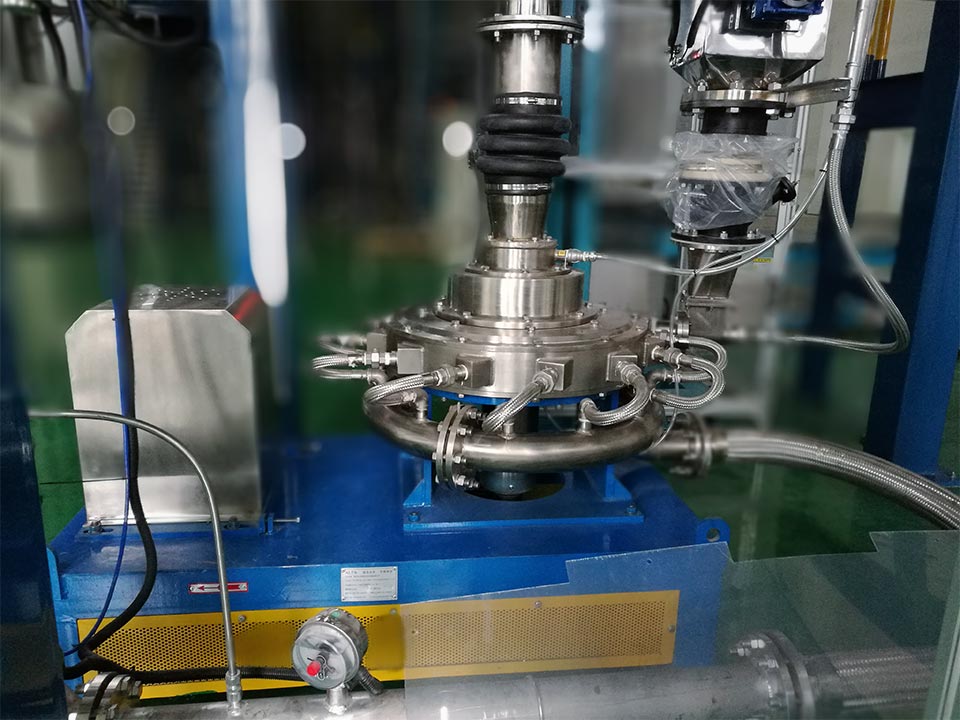
Feed recharge: improper adjustment of the air door, blockage of the pipeline, clogged sieve, poor air permeability or severe wear of the dust bag, severe wear of the hammer surface, etc. will cause the feed recharge. When this phenomenon occurs, you should first find out the cause, and then take the elimination measures, or remove the valve, replace the powder bag, improve the air permeability, or replace the hammer.
Bearing overheating: The bearing is poorly lubricated, damaged or the main shaft is bent, the rotor is seriously unbalanced, and the belt is too tight, and the bearing is overheated. Change the oil, replace the bearing and main shaft, balance the rotor, adjust the belt tightness, etc. to restore the bearing to normal.
The jet mill vibrates strongly: the hammer head is installed incorrectly, the corresponding weight deviation of the two sets of heavy hammers is large, the bearing is damaged or the main shaft is bent, the foot and the screw are loose. For specific reasons, proceed step by step.
Abnormal noise inside the grinder: If parts of the grinder are damaged, fall off or hard objects such as iron and stone enter the machine, abnormal noise will be emitted. The machine should stop running immediately, replace damaged parts or remove hard objects.
Low production efficiency: low production efficiency, insufficient motor power, improper preparation of pulleys, belt slippage, serious hammer wear, uneven raw materials or high moisture content of raw materials. Regular inspections of machines and equipment are required to ensure normal operation, which not only ensures the safety of people’s production, but also improves the efficiency of equipment.
The role of jet mill in pharmacy & fine chemical industry
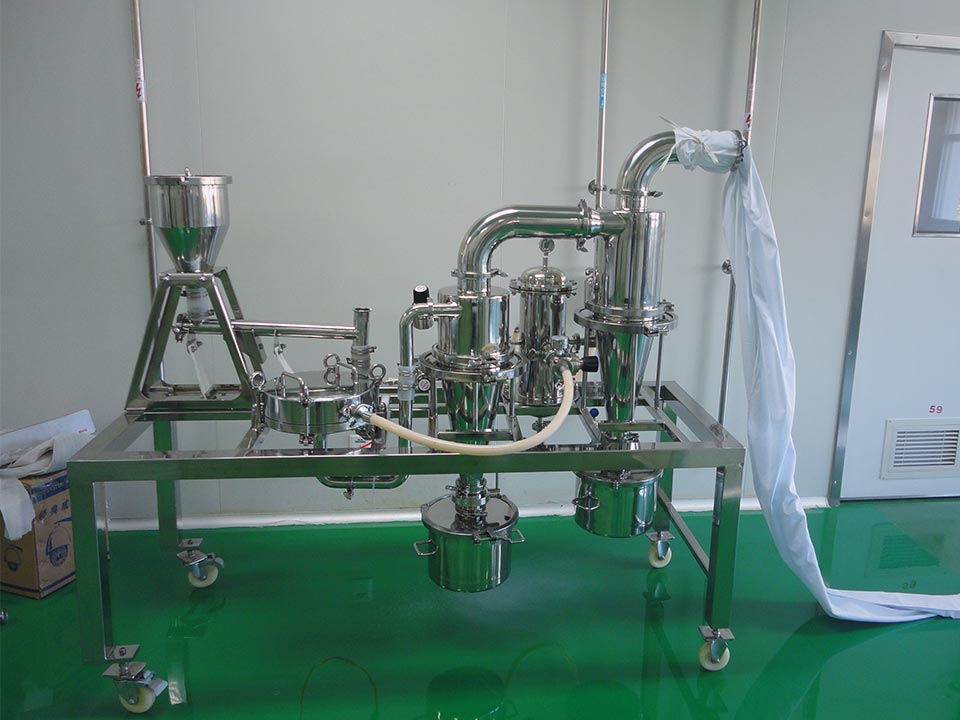
In the modern industry with increasingly sophisticated technology, especially in pharmaceuticals and fine chemicals, ultra-fine grinding is an extremely important and indispensable link. Among them, jet mills are the preferred equipment in the industry, due to the principles and characteristics of the equipment. The following advantages:
1. High product purity: This is because the principle of the jet mill is to use compressed air to bring animal materials to collide and grind by itself, and the compressed air is processed by a cold dryer and a precision filter, and there is no other media to contact and grind. Especially when grinding materials with higher hardness, a ceramic-lined grinding cavity can be used, so no other impurities participate in the grinding.
2. Energy saving and high product efficiency: In the jet mill system, the efficiency of the jet mill is higher than other grinding equipment under the same power consumption.
3. Uniform particle size distribution of the product: Under the condition of controlling the feeding speed and the rotating speed of the grading wheel (fluidized bed jet mill), the particle size of the jet mill tends to a normal distribution.
4. Cryogenic grinding: The temperature of the compressed air, the medium used by the jet mill, is much lower than normal temperature after passing through the cold dryer. This ensures that the grinding process belongs to low temperature grinding, so it is especially suitable for the grinding of heat-sensitive materials.
Equipment composition of jet mill production line
The air source is the driving force for the grinding process of the jet mill. The requirements for compressed air can be between 0.7-0.8MPa, and the pressure can be kept stable, otherwise the quality of the product will be affected. Secondly, the gas quality is required to be clean and dry, and compressed air should be purified to remove water, oil mist, and dust in the gas, so that the material is not polluted, and it is suitable for the grinding of materials with high purity requirements.
The raw material supply is to lift the raw materials into the raw material silo with a hoist, and then send the raw materials into the grinding chamber of the jet mill through the feed valve. This machine has strong adaptability to the particle size of the materials, and generally requires 325 mesh raw materials. The speed of the raw material conveyor is automatically controlled to keep the mixing concentration of raw materials and air in the grinding chamber relatively stable. Two pairs of nozzles are installed symmetrically in the grinding chamber. When the compressed air passes through the nozzles, a supersonic airflow is formed, which accelerates and collides with the animal materials to pulverize the materials into ultra-fine powder. The grinding effect is related to the shape of the inner diameter of the nozzle, distance, symmetry and the mixing concentration of the material and air. The shape of the inner diameter of the nozzle determines the speed and distance at which the speed of sound is formed, and determines the acceleration distance of the material. Speed, raw material and air mixing concentration also affect product size and output.
The classification is carried out by a high-speed rotating classification wheel. The grading wheel is like a round "iron bucket", the center of the bottom is fixed on the main shaft directly connected to the motor, and it is driven by the motor to rotate at high speed. The opening is opposite to the pipe entrance of the micro powder collection system, and a certain gap is maintained. The gap cannot be too large, otherwise the unsorted coarse powder enters the pipe of the micro powder collection system from the gap and affects the product quality. In order to prevent such incidents from happening, air seal treatment is carried out at the gap. The gap between the blades of the classifying wheel is a channel for sorting fine powder. The ground fine powder floats with the airflow. Because of its small particle size, the ultrafine powder can enter the dust collector through the gap between the blades. Under the centrifugal force of the classifying wheel, the larger particles splash to the outer wall and then fall to be ground again. Adjust the rotation speed of the classification wheel to obtain products with different particle sizes.
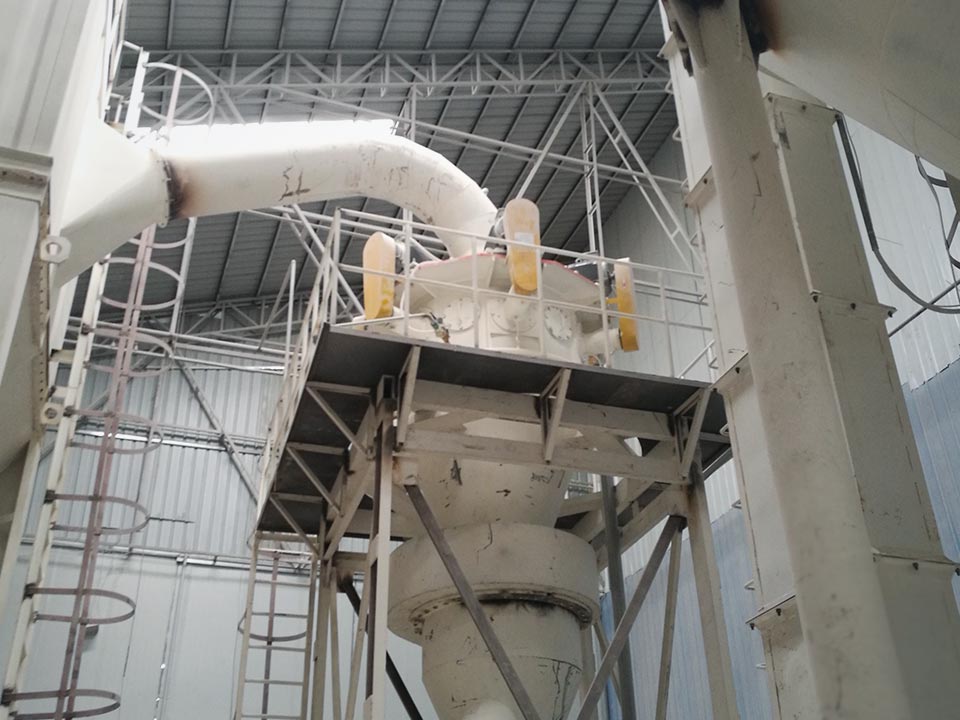
For the control of the mixing concentration of materials and air in the grinding chamber, capacitive material density control switches or sensors can be used. This machine uses the current of the drive motor to control. This control method is simple, feasible and easy to control. When the mixing concentration of materials and air increases, the density of dust floating with the airflow increases, and the dust hitting the classifying wheel increases, which increases the current of the drive motor; on the contrary, the current of the drive motor decreases. Using the size of the motor current to control the amount of conveyed materials can keep the mixing concentration of materials and air stable. When the driving current increases, the conveying will be stopped immediately, so that the powder and the conveying can maintain a dynamic balance to ensure the stability of product quality.
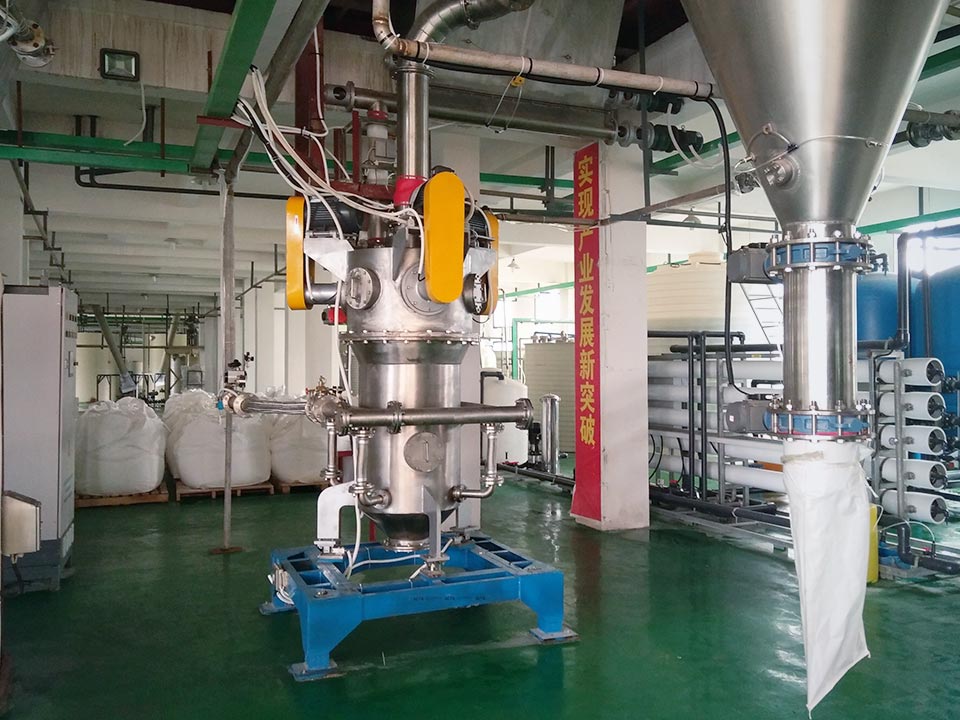
The powder collection system consists of a cyclone separator and dust collection. The ultra-fine powder enters the cyclone separator through the sealed pipe, the airflow rotates in the cyclone separator, and the ultra-fine powder is thrown out and landed, discharged by the discharge system and packaged to be the finished product. The cyclone separator can be used in one or two stages. Some dust from the air flow from the cyclone separator enters the dust collector, and is filtered through a cloth bag. The exhaust gas is drawn out under the action of the induced draft fan, and the dust content is very small. In order to prevent these dusts from being discharged into the atmosphere and polluting the environment, we also add a set of dust filters to recover the dust, and the exhaust gas is finally discharged into the atmosphere. The entire production process is automatically controlled by the control cabinet. The control cabinet supplies the entire production power (not including the gas supply power). It can also control parameter adjustment, automatic start and stop, automatic protection, fault alarm and automatic shutdown to ensure the safe operation of equipment and Stable product quality.
Advantages of jet mill
A good grinding effect is the advantage of the jet mill, but the problems of high cost, high energy consumption, and easy abrasion of the equipment have always been the weaknesses of the jet mill. In recent years, with the continuous improvement of the technical level of the industry, the quality and performance of the products have been significantly improved, and the jet mill has a good market application prospect.
At present, the main objective of the development of the grinding industry in the world is to increase the fineness while increasing the output and expand the scope of application, such as the grinding of materials with high fibrous, high hardness, high toughness, viscous and elasticity, low-temperature grinder, inert gas protection Grinding machines are also the focus of many manufacturers' research and development.
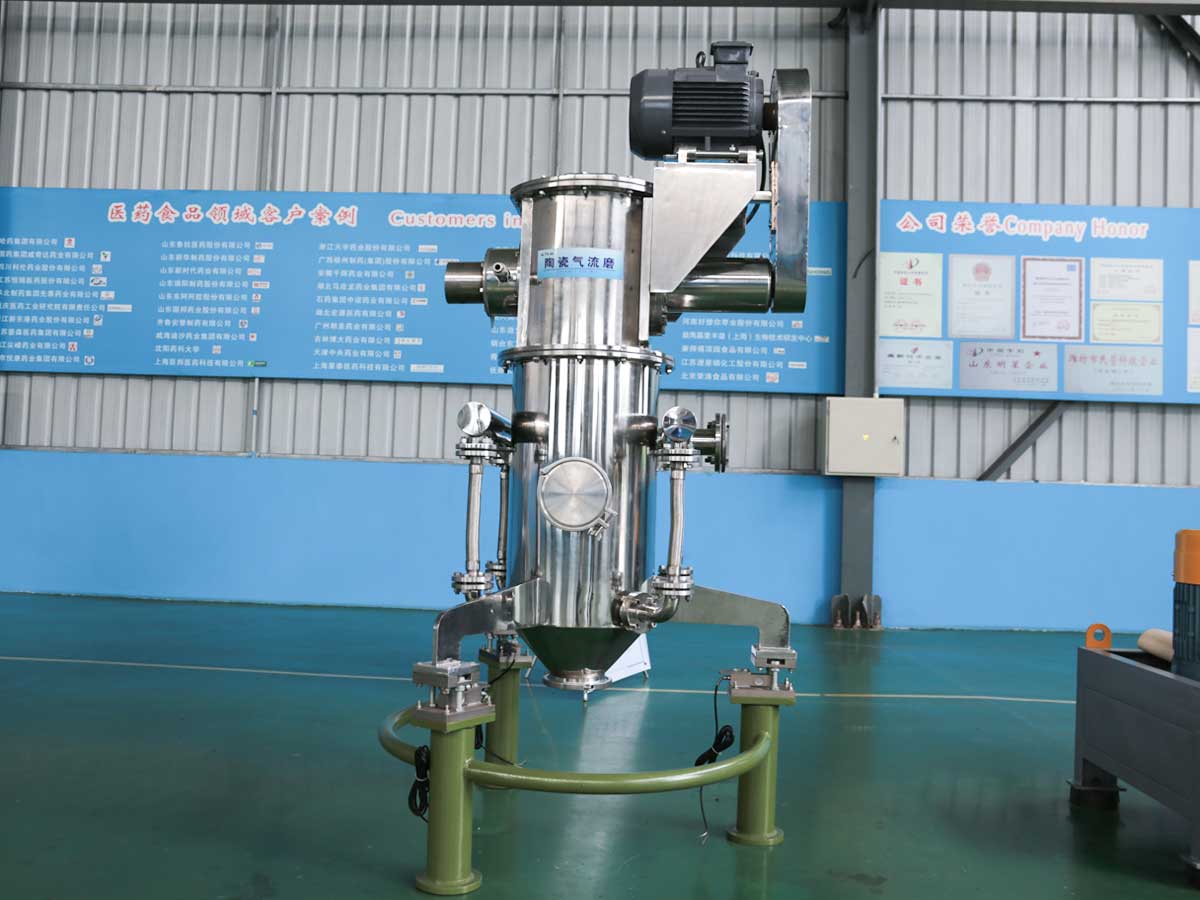
Grinding is a very important part of the pharmaceutical production process, and the grinding equipment should not be underestimated. Among them, jet mills are used in almost all fine processing industries, such as medicine, food, chemical industry, etc., and occupy a special position in many specific powder fields.
The jet mill grinds the material through the impact between the material particles under the action of high-speed airflow, and the impact, friction, and shearing of the airflow on the material and the impact, friction, and shear between the material and other parts. It has the following main characteristics:
1. The grinding temperature is low, and it can grind materials with heat sensitivity and low melting point. When the gas is sprayed from the nozzle and expands adiabatically, the gas will cool itself, thereby offsetting the heat generated by the collision and friction of the material.
2. Short production cycle and high powder collection rate. Due to high-speed collision and closed grinding, the probability of collision between materials is high, and there is no leakage of dust.
3. Products with high purity (less pollution) and uniform particle size distribution can be obtained.
4. For some materials that have to be wet-milled, it can also be dry-milled by jet milling to obtain uniform and fine powder.
5. A variety of combined operations can be realized, and the drying operation can be realized at the same time as grinding.
It can be seen from the above that the jet mill plays an important role in the grinding process of the pharmaceutical industry, and with the continuous development of the pharmaceutical industry, the status of the jet mill will continue to rise.
The extensive processing methods in the past can no longer meet the requirements of traditional Chinese medicine production. Traditional grinders have certain limitations in many aspects such as powder particle size, powder extraction rate, powder collection rate, and preservation of effective ingredients. Air jet milling technology will provide a new way to develop ultra-fine Chinese medicine powder with better curative effect and better varieties.
In the future development road, if the airflow grinding technology is introduced into the processing link of Chinese medicine, a brand-new grinding technology can be created, which not only enriches the content of traditional processing, but also brings a new look to the processing and production of Chinese medicine. It will become the growth point of new technologies in the traditional Chinese medicine industry.
As an important grinding equipment, the jet mill requires continuous technological innovation to improve product performance, improve product structure, and increase the grinding particle size and purity. The research and development of ultra-fine jet mills will be a good choice.
What are the main applications of graphite?
- Traditional applications
1) Refractory materials: Graphite and its products have the properties of high temperature resistance and high strength. It is mainly used in the metallurgical industry to make graphite crucibles. In steelmaking, graphite is often used as a protective agent for steel ingots and as a lining for metallurgical furnaces.
2) Conductive materials: used in the electrical industry to make electrodes, brushes, carbon rods, carbon tubes, positive electrodes of mercury positive current devices, graphite washers, telephone parts, coatings for television picture tubes, etc.
3) Wear-resistant lubricating material: Graphite is often used as a lubricant in the machinery industry. Lubricating oil can not be used under high-speed, high-temperature, and high-pressure conditions, while graphite wear-resistant materials can work at high sliding speeds at a temperature of 200 to 2000 ℃ without lubricating oil. Many equipment for transporting corrosive media widely use graphite materials to make piston cups, sealing rings and bearings, and they do not need to add lubricating oil during operation. Graphite emulsion is also a good lubricant for many metal processing (wire drawing, pipe drawing).
4) Graphite has good chemical stability. Specially processed graphite has the characteristics of corrosion resistance, good thermal conductivity, and low permeability. It is widely used in the production of heat exchangers, reaction tanks, condensers, combustion towers, absorption towers, coolers, heaters, filters, Pump equipment. It is widely used in petrochemical industry, hydrometallurgy, acid-base production, synthetic fiber, papermaking and other industrial sectors, which can save a lot of metal materials.
5) Casting, sand foundry, die and high-temperature metallurgical materials: due to the small thermal expansion coefficient of graphite and the ability to withstand rapid changes in cold and heat, it can be used as a glass mold. After graphite is used, ferrous metals can be used to obtain castings with precise dimensions and a high surface smooth and finished product rate. , Can be used without processing or a little processing, thus saving a lot of metal. The production of cemented carbide and other powder metallurgy processes usually use graphite materials to make porcelain boats for compression molds and sintering. Single crystal silicon crystal growth crucibles, regional refining vessels, support fixtures, induction heaters, etc. are all made of high-purity graphite. In addition, graphite can also be used for vacuum smelting graphite heat insulation boards and bases, high-temperature resistance furnace tubes, rods, plates, grid sheds and other components.
6) Used in the atomic energy industry and national defense industry: Graphite has a good neutron moderator used in atomic reactors. Uranium-graphite reactor is a kind of atomic reactor that is widely used. The deceleration material in the nuclear reactor used as power should have high melting point, stability, and corrosion resistance. Graphite can fully meet the above requirements. As the graphite used in atomic reactors, the purity requirements are very high, and the impurity content should not exceed dozens of PPM, especially the boron content should be less than 0.5 PPM. In the defense industry, graphite is also used to make solid fuel rocket nozzles, missile nose cones, parts of aerospace equipment, heat insulation materials and radiation protection materials.
7) Graphite can also prevent boiler fouling. Tests by related units have shown that adding a certain amount of graphite powder (approximately 4 to 5 grams per ton of water) can prevent boiler surface fouling. In addition, graphite coating on metal chimneys, roofs, bridges, and pipes can prevent corrosion and rust.
8) Graphite can be used as pencil lead, pigment and polishing agent. After graphite is specially processed, various special materials can be made for use in relevant industrial sectors.
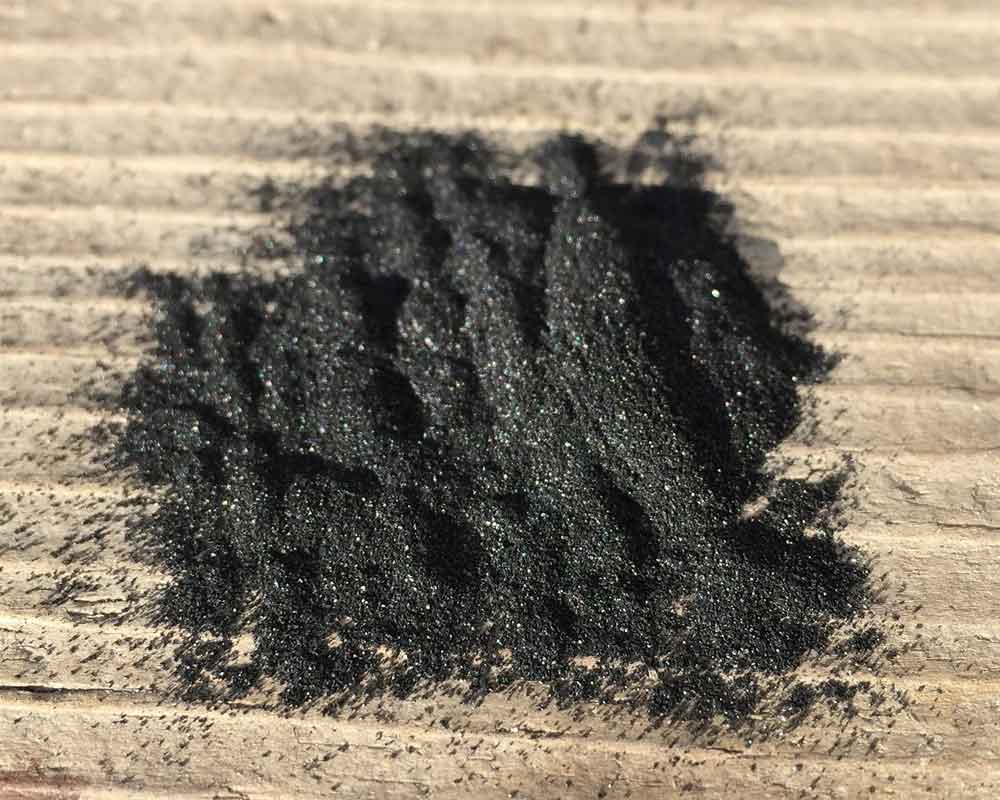
- New applications
1) Flexible graphite products. The flexible graphite sealing material solves the leakage problem of the atomic energy valve. In addition to the characteristics of natural graphite, this product also has special flexibility and elasticity, making it an ideal sealing material. It is widely used in petrochemical, atomic energy and other industrial fields.
2) Graphite is also a polishing agent and anti-rust agent for glass and papermaking in light industry, and is an indispensable raw material for the manufacture of pencils, ink, black paint, ink, synthetic diamonds, and diamonds.
With the development of modern science and technology and industry, the application field of graphite is still expanding. It has become an important raw material for new composite materials in the high-tech field and plays an important role in the national economy.
